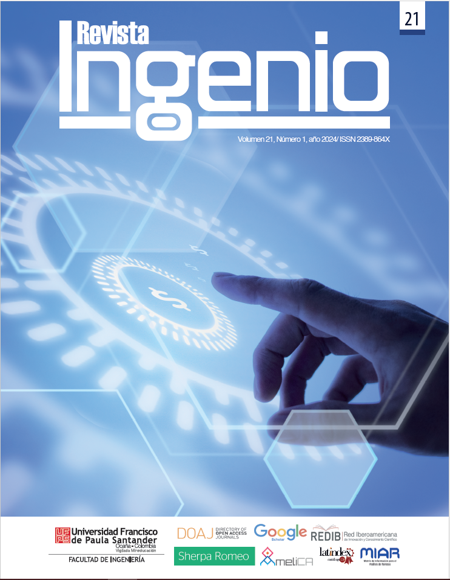Estimation of emissions and modeling of the environmental behavior of greenhouse gases for a landfill
Estimación de emisiones y modelización del comportamiento ambiental de los gases de efecto invernadero para un relleno sanitario
Main Article Content
The study addressed the problem of greenhouse gas (GHG) emissions at the La Cortada Landfill (RSLC) in Pamplona, Norte de Santander. Since its creation in 2006, this landfill has received a significant amount of waste daily, contributing to the constant release of GHGs. The main objective was to estimate GHG emissions, understand their trajectories and model their dispersion in the environment. To achieve this, specialized tools such as LandGEM, Hysplit and Aermod were used, satellite images from the OLI sensor on board the Landsat 8 satellite were selected in periods between August and October from 2016 to 2020. An empirical methane estimation model was also applied. (estimated CH4), which relates land surface temperature (LST) to methane concentrations measured in the field between 2021-2023 (observed CH4). The results showed that measurements using satellite images gave lower values than those obtained in the field (0.007 mg/m3 per year, annual average of Estimated CH4) and (0.05 mg/m3 per year, annual average of observed CH4). In conclusion, The RSLC represented a significant source of GHGs, and this estimation approach based on satellite imagery and field measurements validated the importance of addressing these emissions to promote more sustainable solid waste disposal practices and protect air quality and regional well-being. , likewise allows arguing the implementation of biogas capture systems in the landfill to reduce methane (CH4) emissions, and the exploration so that this resource can be used as a source of renewable energy to produce heat or electricity, which would contribute to sustainability and emissions reduction.
Downloads
Article Details
DNP, D. D. P. (2016). Rellenos sanitarios de 321 municipios colapsarán en cinco años, advierte el DNP.
Tello, D., Peña, K., Hernández, F. “Estimation of methane (CH4) emission in the Presidente landfill through satellite images”. Revista de Topografía Azimut, (11), pp: 11-17. 2019. https://revistas.udistrital.edu.co/index.php/azimut/article/view/15654/15698
Colomer, F.; García, F.; Altabella, J.; Robles, F. y Aranda, G. (2017). Emisiones gaseosas de un relleno sanitario en México. Comparación con modelos de generación de biogás. Revista Internacional de Contaminación Medioambienta 32, 113 a 122. http://dx.doi.org/10.20937/RICA.2016.32.05.08 DOI: https://doi.org/10.20937/RICA.2016.32.05.08
Vega C. (2019). Estimation of GHG emissions and their trajectories in large forest fires in Catalonia, Spain. Instituto de Ecología A.C. Madera y bosques, vol. 25, No. 2, E2521764, 2019 https://www.redalyc.org/jatsRepo/617/61762610002/html/index.html
Ortega, J., Becerra, D., Barajas, F., Ramírez, L. y Sanguino, P. “La gestión ambiental y su impacto en el desarrollo de las actividades productivas”. San José de Cúcuta, Norte de Santander, Colombia: Programa de Ingeniería Ambiental. 2018. chrome-extension://efaidnbmnnnibpcajpcglclefindmkaj/https://ww2.ufps.edu.co/public/archivos/pdf/2c733eaa97e54198fb591e215fecaf1f.pdf
Sánchez, J., Contreras, M., and Torres, J. Geotechnical characterization of the subsoil in the regional landfill la “Cortada”, Pamplona (Norte de Santander) from geophysical data. Colombian Journal of Advanced Technologies, 9-17. 2020. doi: https://doi.org/10.24054/16927257.v36.n36.2020.3991
Sofán, S., Ruíz, A., Arrieta, J. y Doria, M. (2023). “Evaluación energética de la formación de biogás obtenido a partir de residuos sólidos municipales procedentes del relleno sanitario utilizando el modelo LandGEM” Investigación e Innovación en Ingeniería, 11(2), 16-27. 2023 https://revistas.unisimon.edu.co/index.php/innovacioning/article/view/6373 DOI: https://doi.org/10.17081/invinno.11.2.6373
Ambuludi, R. y Carvajal, V. (2022). “Estimación de gas metano utilizando el modelo LandGEM del relleno sanitario de residuos sólidos municipales Patate-Pelileo, Tungurahua, Ecuador”. Revista Tecnología , 35(1), 67-78. 2022 https://www.scielo.sa.cr/scielo.php?script=sci_arttext&pid=S0379-39822022000100067
Vergara, K. “Estimación de la respuesta hidrológica de la subcuenca del río Chagres bajo diversos escenarios de cambio climático mediante la implementación de la herramienta HYDRO-BID”. República de Panamá: Universidad de Panamá. 2023. http://up-rid.up.ac.pa/6557/
Ballesteros, F. “Implementación de una red de sensores inalámbricos para el monitoreo de la calidad del aire. Universidad Autónoma de Bucaramanga: Bucaramanga” 2023. cromo-extension://efaidnbmnnnibpcajpcglclefindmkaj/https://repository.unab.edu.co/bitstream/handle/20.500.12749/14337/2021_Tesis_Fabian_Ballesteros.pdf?sequence=1&isAllowed=y
Ministerio de Vivienda, Ciudad y Territorio. “Decreto 1784”. 2017. https://dapre.presidencia.gov.co/normativa/normativa/DECRETO%201784%20D ON%2002%20DE%20NOVEMBER%20DE%202017.pdf
Castro, G. “Metodología para determinar la cantidad de material particulado en la capa de la troposfera a partir de la teledetección. Área de estudio: Valle de Aburrá, Antioquia, para el año 2016”. 2019. Universidad Católica de Manizales: chrome-extension://efaidnbmnnnibpcajpcglclefindmkaj/file:///C:/Users/luval/Downloads/Geraldine%20Castro%20Coca%20(1).pdf
Avdan, U. y Jovanovska, G. “Algoritmo para mapeo automatizado de la temperatura de la superficie terrestre utilizando datos del satélite LANDSAT 8”. Revista de sensores, 2016, 1-8.
Cortez, J. “Estimación de emisiones de metano del Relleno Sanitario Bordo Poniente por medio de imágenes de satélite (Doctoral dissertation, Tesis de maestría)”. Ciudad de México, Instituto Politécnico Nacional) 2013.
Centro de Objetivos de Desarrollo Sostenible para América Latina [CODS] “Lo que Colombia necesita para reducir sus emisiones en un 51% para 2030” 2021 https://cods.uniandes.edu.co/lo-que-necesita-colombia-para-reducir-sus-emisiones-en-un-51-para-el-ano-2030/
Triveño, R. N. C. (2016). PRECISIÓN DE LOS GPS NAVEGADOR. El Antoniano, 131(1), 109-113. DOI: https://doi.org/10.51343/anto.v131i1.67
Corponor. “Resolución N.0026” 2021. chrome-extension://efaidnbmnnnibpcajpcglclefindmkaj/https://corponor.gov.co/web/wp-content/uploads/2021/01/RESOLUCIO%CC%81N-0026-DE-19-JANUARY-2021.pdf
A. J. Cardona-Vargas, C. Echeverri-Uribe, J. Zapata-López, J. Jaramillo-Álvarez, C. Arrieta-Gónzalez, y A. Amell-Arrieta, “Cálculo de propiedades de combustión y análisis de estabilidad de llama para el gas límite 65%CH4 + 35%H2”, Revista Ingenio, vol. 17, n.º 1, pp. 1–8, ene. 2020, doi: https://doi.org/10.22463/2011642X.2328 DOI: https://doi.org/10.22463/2011642X.2328
J. E. Salinas-Carrillo, O. L. Pérez-Castañeda, B. J. Arango-Perdomo, y E. López-Sánchez, “Una propuesta de cálculo de día solar local”, Revista Ingenio, vol. 19, n. º 1, pp. 45–51, ene. 2022, doi: https://doi.org/10.22463/2011642X.3241 DOI: https://doi.org/10.22463/2011642X.3241







